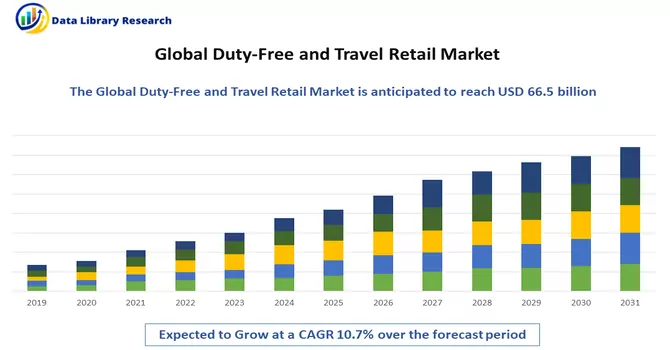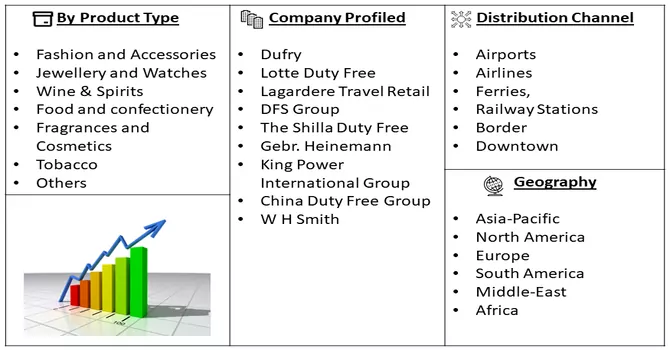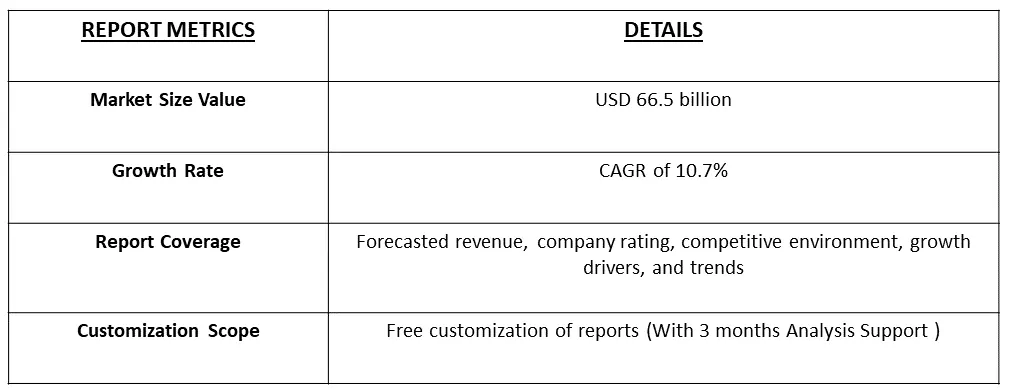In 2022, the global Travel Retail and duty-free Market achieved a valuation of USD 66.5 billion, with an anticipated Compound Annual Growth Rate (CAGR) of 10.7% forecasted for the period spanning 2023 to 2030.

Get Complete Analysis Of The Report - Download Free Sample PDF
The duty-free and travel retail sector encompasses the retailing of goods to international travellers, primarily situated in locations such as airports, seaports, border crossings, and various travel hubs. Within these retail spaces, passengers are presented with the opportunity to purchase a diverse array of products, ranging from luxury items and cosmetics to electronics and fashion, often at prices exempt from specific local taxes and duties. Purchases can be made either before departure, commonly known as duty-free, or upon arrival, termed as travel retail.
A significant growth driver for the duty-free and travel retail industry is the burgeoning international travel and tourism sector. The increasing number of individuals embarking on international travel for business or leisure has led to rising demand for retail offerings within travel hubs. The continual expansion and enhancement of airports and other travel hubs on a global scale further contribute to the sector's growth. The establishment of new terminals and the surge in passenger traffic create favourable opportunities for retailers to either establish a presence or expand their existing footprint in this dynamic industry.
The industry is undergoing a notable transformation marked by a substantial move towards digitalization and the seamless integration of e-commerce. Travellers are progressively participating in online pre-ordering and embracing digital shopping experiences prior to their arrival at the travel destination, thereby elevating levels of convenience and efficiency. Duty-free and travel retail operators are actively investing in cutting-edge technologies to provide personalized shopping experiences. This strategic focus entails the implementation of targeted promotions, the introduction of loyalty programs, and the delivery of personalized recommendations tailored to individual traveller preferences and purchase history. By leveraging these technological advancements, operators aim to enhance customer engagement and satisfaction, creating a more tailored and enjoyable shopping journey for travelers.
Market Segmentation: The Global Duty-Free and travel Retail Market is Segmented by Product Type (Fashion and Accessories, Jewellery and Watches, Wine & Spirits, Food and confectionery, Fragrances and Cosmetics, Tobacco, Others (Stationery, Electronics, etc.)), By Distribution Channel (Airports, Airlines, Ferries, Other (Railway Stations, Border, Downtown)) and By Geography (North America, South America, Europe, Asia-Pacific, and the Middle East and Africa). The report offers market size and forecasts for Global Duty-free and Travel Retail Market in value (USD Million) for all the above segments.

For Detailed Market Segmentation - Download Free Sample PDF
The global duty-free and travel retail market has experienced a significant impact due to the COVID-19 pandemic. The travel restrictions, lockdowns, and overall reduction in international travel have led to substantial disruptions in the industry. The imposition of travel restrictions and lockdowns resulted in a sharp decline in passenger traffic at airports and other travel hubs. With fewer people travelling, the duty-free and travel retail market faced a drastic reduction in its customer base. The global supply chain disruptions caused by the pandemic impacted the availability of certain products in duty-free shops. Manufacturing and logistics challenges led to delays and shortages, further affecting the market. Thus, the COVID-19 pandemic has presented substantial challenges for the duty-free and travel retail market, leading to decreased revenue, changes in consumer behavior, supply chain disruptions, and an accelerated shift towards digitalization. The industry is now navigating towards recovery, adapting to the new normal in travel and retail experiences.
Market Drivers:
Increase in International Travel
The expansion of international travel plays a pivotal role in propelling the duty-free and travel retail industry forward. As an increasing number of individuals partake in international tourism and business travel, there is a corresponding surge in demand for retail offerings within key travel hubs like airports, seaports, and border crossings. This heightened demand is particularly influenced by the growing global middle class, whose increased connectivity and the greater affordability of air travel have collectively contributed to a significant uptick in international travelers. The accessibility and affordability of air travel, along with the expanding global middle class, have synergistically led to a notable increase in the number of individuals embarking on international journeys. This influx of passengers presents duty-free and travel retail operators with a burgeoning customer base. The result is a positive impact on sales and creates opportunities for business expansion within the duty-free and travel retail sector. In essence, the growth in international travel serves as a catalyst for the industry, fostering increased commercial activity and market expansion.
Luxury Goods Market and Premium Brands
The duty-free and travel retail sector derives considerable advantage from the robust presence of luxury and premium brands. Travelers frequently view duty-free shopping as an enticing opportunity to acquire high-end products such as designer fashion, luxury accessories, cosmetics, and electronics at a more affordable cost, thanks to tax exemptions. The allure of prestigious brands and the availability of exclusive offerings serve as powerful motivators, enticing travellers to explore these retail spaces and make purchases. The appeal of renowned luxury brands plays a pivotal role in shaping the shopping preferences of travellers. The perception of acquiring coveted items at a reduced cost amplifies the attractiveness of duty-free and travel retail outlets. This dynamic is particularly pronounced among discerning and affluent travellers who seek access to premium products during their journeys. Furthermore, the sustained growth of the global luxury goods market significantly contributes to the success of duty-free and travel retail establishments. These outlets are strategically positioned to cater to the preferences of travellers who have a penchant for premium and exclusive products. The symbiotic relationship between the duty-free and travel retail sector and the luxury goods market creates a mutually reinforcing environment, fostering continued success and desirability for these retail spaces among discerning clientele.
Market Restraints:
Travel Restrictions and Border Closures and Fluctuations in Tourism and Passenger Traffic
A notable challenge confronting the duty-free and travel retail industry arises from the imposition of travel restrictions and border closures, as exemplified during global occurrences such as the COVID-19 pandemic. These restrictions act as limiting factors on the influx of international travelers, resulting in a notable reduction in foot traffic through pivotal travel hubs and a consequent downturn in sales for duty-free retailers. The industry exhibits vulnerability to fluctuations in tourism and passenger traffic. Economic downturns, geopolitical events, natural disasters, and health crises represent additional factors capable of impacting travel patterns, ultimately leading to a reduction in the number of passengers frequenting duty-free and travel retail outlets. The susceptibility of the industry to unpredictable changes in global events amplifies the potential for decreased consumer spending within these locations. Consequently, the overall revenue for retailers operating in duty-free and travel retail environments faces the challenge of being adversely affected by the dynamic and unpredictable nature of external factors that influence travel behavior and patterns. In essence, the industry's resilience is continually tested by the unforeseen and external events that can significantly alter the landscape of international travel.
Segmentation Analysis:
Stationery Segment is Expected to Witness Significant Growth Over the Forecast Period
Duty-free and travel retail establishments are attuned to the requirements of business travelers who may necessitate stationery items for work-related activities during their journeys. Essential products like notebooks, pens, folders, and various office supplies are readily accessible, offering convenience to individuals seeking to stay organized and productive while on the move. Stationery items not only cater to practical needs but also serve as popular and thoughtful gifts or souvenirs for travelers. Unique and aesthetically pleasing offerings such as distinctive notebooks, locally designed pens, or specialty paper products present appealing choices for tourists looking to acquire a tangible memento from their destination. This thoughtful selection of stationery items within duty-free and travel retail outlets adds an extra layer of convenience and personalization to the overall shopping experience for a diverse range of travelers. Thus, owing to such benefits the segment is expected to witness significant growth over the forecast period.
Airline Segment is Expected to Witness Significant Growth Over the Forecast Period
The Airport and Duty-Free & Travel Retail Market represent integral components of the global travel experience, contributing significantly to the economic landscape and providing passengers with a diverse array of retail opportunities. Airports serve as bustling hubs of commercial activity, housing a variety of retail spaces ranging from duty-free shops to specialty boutiques. Major international airports feature renowned global retail brands, offering passengers access to a broad spectrum of products, including luxury goods, electronics, fashion, and local merchandise. Thus the Airport and Duty-Free & Travel Retail Market remain dynamic and vital components of the travel ecosystem, continually evolving to meet the changing needs and preferences of today's global travelers.
North America Region is Expected to Witness Significant Growth Over the Forecast Period
Several major international airports in North America function as significant retail hubs, with notable examples including Hartsfield-Jackson Atlanta International Airport, Los Angeles International Airport, and John F. Kennedy International Airport. These airports boast expansive duty-free and travel retail sections, effectively catering to the diverse needs of both domestic and international travelers navigating through these pivotal transportation hubs.
In the North American region, a discernible trend is emerging with an increasing preference for differentiated and value-added products, contributing to a heightened desire for travel. This, in turn, is anticipated to drive demand within the duty-free industry. The market may experience growth due to the adoption of new lifestyles and the availability of cost-effective destination travel packages offered by companies such as MakeMyTrip, Cleartrip, and GoIbibo. Furthermore, the rapid penetration of social media and digitalization within the economy is poised to create lucrative opportunities for vendors operating in the Asia-Pacific market throughout the forecast period. This digital transformation is expected to play a pivotal role in reshaping and enhancing the overall duty-free and travel retail experience, offering vendors in the Asia-Pacific region a strategic avenue for growth and innovation.

Get Complete Analysis Of The Report - Download Free Sample PDF
The duty-free and travel retail market is highly fragmented. The boom of the travel and tourism industry is encouraging consumers to open new outlets and chains in the duty-free and travel retail market. The increasing focus on offering a diverse and wide range of products may enable the vendors to attract a large number of consumers and gain large market shares. The adoption of innovative promotional campaigns and attractive price offerings may help the players sustain the competition in the duty-free and travel retail market. The report covers major international players operating in this sector. In terms of market share, few of the major players currently dominate the market. Some of the market players working in this market segment are:
Recent Developments:
1) In February 2021, Dufry-owned Hudson Group officially opened its first Hudson Nonstop store using Amazon's Just Walk Out technology at Dallas Love Field Airport (DAL). The Just Walk Out technology allows customers to pick up products in a physical store, pay for their items, and leave.
2) In January 2021, DFS opened the first phase of a new downtown duty-free retail complex in Haikou Mission Mills, Hainan, on January 30, 2021, in partnership with Shenzhen Duty-Free Group. DFS Group is to feature a luxury line-up across various categories at the first China International Consumer Products Expo to be held in Hainan on May 7-10, 2021. Co-sponsored by the Ministry of Commerce and the People's Government of Hainan Province, the Consumer Expo is the first state-level exhibition to focus on consumer products.
Q1. What was the Duty-Free and Travel Retail Market size in 2022?
As per Data Library Research the global Duty-Free and Travel Retail Market achieved a valuation of USD 66.5 billion in 2022.
Q2. At what CAGR is the Duty-Free and Travel Retail Market projected to grow within the forecast period?
Duty-Free and Travel Retail Market is anticipated Compound Annual Growth Rate (CAGR) of 10.7% over the forecast period.
Q3. What segments are covered in the Duty-Free and Travel Retail Market Report?
By Product Type, By Distribution Channel, End-User and Geography are the segments covered in the Duty-Free and Travel Retail Market Report.
Q4. What are the factors driving the Duty-Free and Travel Retail Market market?
Key factors that are driving the growth include the Increase in International Travel and Luxury Goods Market and Premium Brands.
Data Library Research are conducted by industry experts who offer insight on industry structure, market segmentations technology assessment and competitive landscape (CL), and penetration, as well as on emerging trends. Their analysis is based on primary interviews (~ 80%) and secondary research (~ 20%) as well as years of professional expertise in their respective industries. Adding to this, by analysing historical trends and current market positions, our analysts predict where the market will be headed for the next five years. Furthermore, the varying trends of segment & categories geographically presented are also studied and the estimated based on the primary & secondary research.
In this particular report from the supply side Data Library Research has conducted primary surveys (interviews) with the key level executives (VP, CEO’s, Marketing Director, Business Development Manager and SOFT) of the companies that active & prominent as well as the midsized organization
FIGURE 1: DLR RESEARH PROCESS

Extensive primary research was conducted to gain a deeper insight of the market and industry performance. The analysis is based on both primary and secondary research as well as years of professional expertise in the respective industries.
In addition to analysing current and historical trends, our analysts predict where the market is headed over the next five years.
It varies by segment for these categories geographically presented in the list of market tables. Speaking about this particular report we have conducted primary surveys (interviews) with the key level executives (VP, CEO’s, Marketing Director, Business Development Manager and many more) of the major players active in the market.
Secondary ResearchSecondary research was mainly used to collect and identify information useful for the extensive, technical, market-oriented, and Friend’s study of the Global Extra Neutral Alcohol. It was also used to obtain key information about major players, market classification and segmentation according to the industry trends, geographical markets, and developments related to the market and technology perspectives. For this study, analysts have gathered information from various credible sources, such as annual reports, sec filings, journals, white papers, SOFT presentations, and company web sites.
Market Size EstimationBoth, top-down and bottom-up approaches were used to estimate and validate the size of the Global market and to estimate the size of various other dependent submarkets in the overall Extra Neutral Alcohol. The key players in the market were identified through secondary research and their market contributions in the respective geographies were determined through primary and secondary research.
Forecast Model
